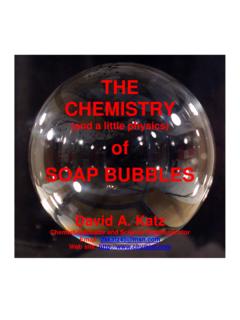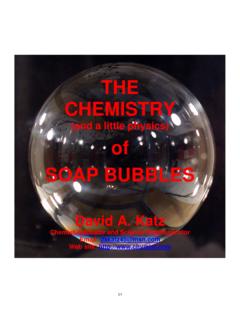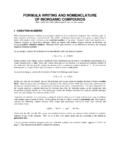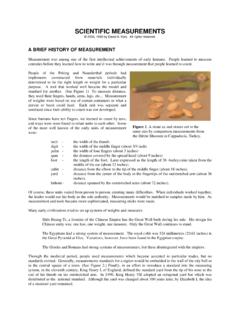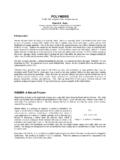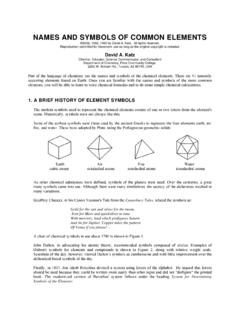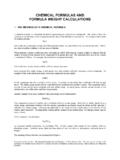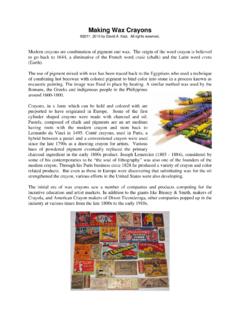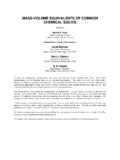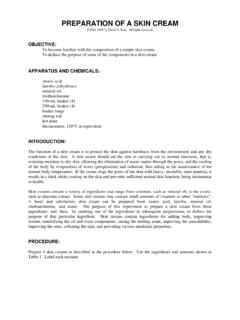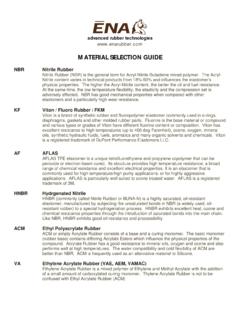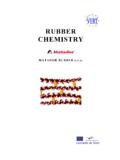Transcription of Preparation of Synthetic Rubber - chymist.com
1 1 Preparation of Synthetic Rubber 2010 by David A. Katz. All rights reserved. Natural latex is found in the inner bark of many trees, especially those found in Brazil and the Far East. The white sticky sap of plants such as milkweed and dandelions is also a latex. Latex will turn into a rubbery mass within 12 hours after it is exposed to the air. The latex protects the tree or plant by covering any wound to the bark or tree surface with a rubbery material like a bandage. Natural Rubber is a polymer of isoprene (2-methyl-1,3-butadiene, see Figure 1) in the form of polymeric chains (See Figure 2) which are joined in a network structure of folded chains and have a high degree of flexibility (See Figure 3).
2 Upon application of a stress to a Rubber material, such as blowing up a balloon or stretching a Rubber band, the polymer chain, which is randomly oriented, undergoes bond rotations allowing the chain to be extended or elongated (See Figure 4). The fact that the chains are joined in a network allows for elastomeric recoverability since the cross-linked chains cannot irreversibly slide over one another. The changes in arrangement are not constrained by chain rigidity due to crystallization or high viscosity due to a glassy state. Since latex will solidify in air, a stabilizer is added to prevent polymerization if the latex is to be stored or shipped in liquid form.
3 The stabilizer is usually to 1% ammonia. When the ammonia is removed by evaporation or by neutralization, the latex will solidify into Rubber . Figure 1. 2-methyl-1,3- butadiene CH3 CH2=C CH=CH2 Figure 2. A Rubber polymeric chainFigure 3. Schematic sketch of a typical elastomeric network Figure 4. Elastic deformation of a Rubber chain 2 Synthetic Rubber is produced from petroleum-based hydrocarbons such as isoprene, butadiene, chloroprene, isobutylene, and styrene. (See Figure 5) Hundreds of Synthetic Rubber compounds have been developed for many diverse applications.
4 Polysulfide rubbers were among the first commercial Synthetic rubbers produced. Two chemists, Joseph C. Patrick and Nathan Mnookin, were trying to invent an inexpensive antifreeze in 1926. In an experiment involving ethylene dichloride and sodium polysulfide, they created a gum whose outstanding characteristic was a terrible odor. Trying to dispose of it, the substance clogged a sink in the laboratory, and none of the solvents used to remove it were successful. The chemists realized that the resistance of the material to any kind of solvent was a useful property. They had invented Synthetic Rubber , which they christened "Thiokol," from the Greek words for sulfur (theion) and glue (kolla).
5 The Thiokol Chemical Corporation was subsequently founded on December 5, 1929. Thiokol Rubber is resistant to natural oxidants such as oxygen and ozone and to organic solvents such as oils and gasoline. This makes it useful for engine O-rings, gaskets, and hoses which may come in contact with oils. Thiokol can be prepared by the reaction of 1,2-dichloroethane and sodium polysulfide. Cl-CH2-CH2-Cl + Na2Sx Cl-[-CH2-CH2-S-S-]n-CH2-CH2-Cl + 2n NaCl In this experiment, you will prepare a sample of a polysulfide Rubber . During the Preparation , you will use some natural Rubber latex to make a small Rubber ball. After the preparations, you can compare the properties of the two types of Rubber .
6 Butadiene isoprene chloroprene Figure 5. Some monomers used to produce Synthetic rubbers 3 Part 1. The Small-Scale Preparation of Thiokol Rubber This Preparation of Thiokol Rubber is a two-step process. The first step is the Preparation of sodium polysulfide by the reaction of sulfur, S8, with a strong base, sodium hydroxide, NaOH. S8 + 2 NaOH Na2S8 At room conditions, sulfur is normally in the form of S8 rings and chains. The reaction with sodium hydroxide produces a mixture of mostly Na2S8 with other chain lengths of sulfur present.
7 That mixture is called sodium polysulfide. The second step of this Preparation is the reaction of sodium polysulfide with ethylene dichloride. Cl-CH2-CH2-Cl + Na2Sx [-CH2-CH2-S8-]n + 2n NaCl Materials Needed Sodium hydroxide solution, 1M Sulfur 1,2-dichloroethane Distilled or deionized water Copper wire, approximately 6 inches long (15 cm) 2 10-mL vials with Teflon cap liners 2 400-mL beakers 10 mL graduated cylinder Glass pipette (dropper) Hot plate Chemical resistant gloves Safety Wear safety goggles at all times in the laboratory. Sodium hydroxide solution is corrosive. Although the solution used in this experiment is dilute, if any splashes on the skin, immediately rinse well with room temperature water.
8 If some redness of the skin occurs, seek medical attention. 1,2-dichloroethane is flammable, avoid any fires or sparks. It is also an irritant to the skin and eyes and is toxic by ingestion. Work with this only under a fume hood. Disposal Dispose of all liquid wastes in the proper waste bottle provided. Dispose of the vials in the waste bucket provided. Procedure Prepare a water bath by filling a 400-mL beaker with approximately 350-mL of deionized water. Place the beaker on a hot plate and allow the water to come to a boil. 4 Weigh g of sulfur and add it to the vial. Add 5 mL of 1 M sodium hydroxide to the vial. Seal the vial tightly. Shake the reaction mixture. Wrap the copper wire around the vial leaving several inches to serve as a handle.
9 Place the vial in the boiling water. Heat for about 3 minutes. Remove the vial from the water. Make sure the cap is tight. Invert the vial several times to mix the contents, then place it back into the boiling water. Heat the vial for 5 minutes. Remove the vial, invert several times to mix the contents and replace it into the boiling water for an additional 5 minutes. The contents should turn red during this heating. Remove the vial from the boiling water and allow it to cool for a few minutes. (Leave the beaker of hot water on the hot plate. It will be used again shortly.) Place the vial in a beaker of cold water for two minutes. Move the apparatus to a fume hood. Working under the hood, remove the vial from the cold water.
10 Remove the copper wire handle and the cap and decant the red solution only into a clean vial, leaving any solid behind in the first vial. Reseal the first vial and place it in the waste bucket under the waste hood. Using a glass dropper, add 1 mL of 1,2-dichloroethane to the red sodium polysulfide solution in the second vial. Seal it tightly. Reattach the wire handle. Vigorously shake the reaction mixture. Then place it back into the boiling water bath. NOTE: If any bubbles begin to flow out of the vial cap during the reaction, remove the vial from the water, allow it to cool, and tighten the cap. After about 3 minutes of heating, remove the vial from the boiling water.
